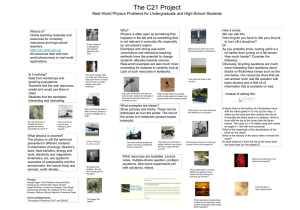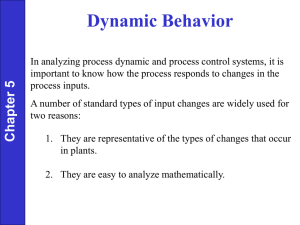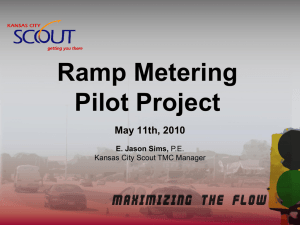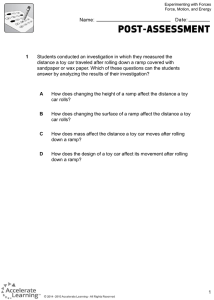Inverter Controls Model Overview
advertisement
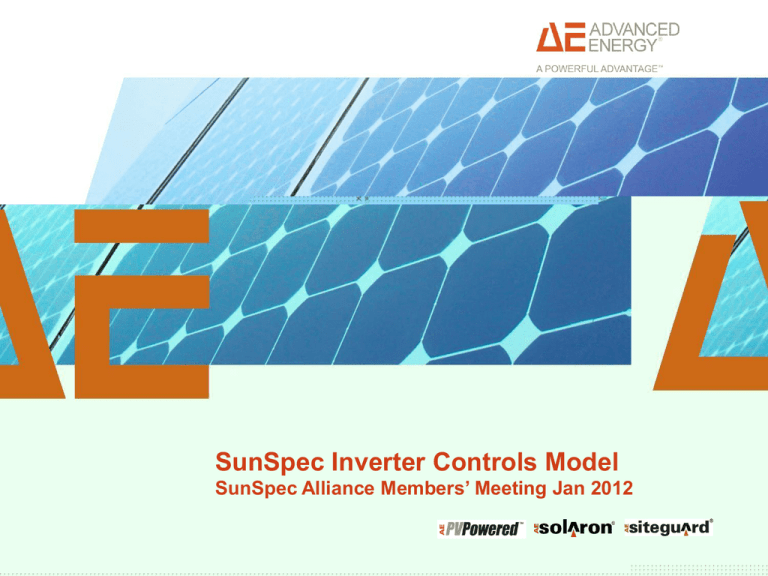
SunSpec Inverter Controls Model SunSpec Alliance Members’ Meeting Jan 2012 Inverter Controls Model Defines a model for support of programmed, scheduled and autonomous inverter control operations. New inverter control modes to be optional on a feature basis, via a set of new SunSpec Device Identifiers (DIDs). Allows the inverter to offer a set of capabilities to clients and for those clients to discover the capabilities of the inverter and to skip function blocks it does not recognize or implement. Applies to PV inverters, with or without battery storage. Based on past and on-going work in various industry and standards bodies, including IEC TC57/WG17, DNP3 User’s Group and EPRI. o Aligns with IEC draft 61850-90-7 and EPRI draft 1023059. Current Inverter Model Basic inverter measurements and status; no control operations. Two maps defined: integer with scale factors and floating point without scale factors. Unique DID for each map. Inverter model map elements: o o o o o o AC current and voltages (all phases) and scale factors AC power, AC frequency, AC VA, AC VAR, AC PF, AC Energy DC current, voltage, power and scale factors Temperatures (4) and scale factor SunSpec status (enumeration), vendor defined status SunSpec event flags (64 bits), vendor defined event flags (128 bits) Inverter Controls Model Overview Nameplate Ratings Basic Settings Extended Measurements and Status Controls o o o o o o o o o o Immediate Controls Basic Storage Pricing Signal Static Volt-VAR Arrays Frequency-Watt Curve Dynamic Reactive Current LVRT/HVRT Arrays Watt-PF Voltage-Watt Basic Scheduling Chained Control Blocks with Defined Device IDs Nameplate Ratings Read-only values set by inverter manufacturer o o Inverter Ratings (Watt, VA, VAR) Storage Ratings (Amps, Ahr, Whr, Max Charge Rate, Max Disch. Rate Required if any controls blocks are used Basic Settings Operating limits and reference values used in control functions o o WMax, PRef, VMin, VMax, VAMax, VarMax, VRef, VRefOfs MaxWLimPct, ECPNomHz Default ramp rates o MaxRmpRte Measurement/setting meanings o PFSign, VarAct, ClcTotVA, ConnectedPhase Required if any controls blocks are used Extended Measurements/Status Inverter present/available Storage present/available ECP connection status Real energy (64-bits) Apparent energy (64-bits) Reactive energy by quadrant (64-bits each) Available VARs Time source and current time Required if any controls blocks are used Immediate Controls Connect/disconnect from grid Max power output [curtailment] (% WMax) Fixed PF (cos(ϕ) + excitation) Fix VAR (% VarMax) Plus random time window, reversion time, ramp time Basic Storage Setpoints for max charge, max charging VA Set maximum charge/discharge gradients Set minimum reserve storage (% max storage) Status/Measurements o Charge state, state of charge, battery voltage, charge status Set storage control mode (charge/discharge) Ramp rates o o Power output rate, power input rate Random window, reversion time, ramp time for in/out power rates Grid charge allowed (yes/no) Pricing Signal Pricing signal type o o o o Absolute price Relative price Price multiplier Qualitative (high/medium/low) Pricing signal value Random window, reversion time, ramp time Used with built-in pricing knowledge or pricing schedule Static Volt-VAR Curve-based description of response o o Variable number of curves (recommend min 4) Variable number of points (recommend min 10) Curves contain points and filter/ramp values o o o o Volt-VAR pairs as %VRef and %VarAval Low pass filter time (seconds) Increment and decrement ramps (%VarAval/min) Number of active points in curve Random time window, reversion time, ramp time Frequency-Watt Parameter or curve-based Parameter method o o o o Watt reduction gradient Start frequency Stop frequency Hysteresis Curve-based description of response o Variable number of curves (recommend min 4) o Variable number of points (recommend min 10) Curves contain points and filter/ramp values o o o o Frequency-Watt pairs as Hertz and %PRef Low pass filter time (seconds) Increment and decrement ramps (%WMax/min) Number of active points in curve Dynamic Reactive Current Support Inject additional reactive current based on change in voltage Upper/lower zone limits, outside which no additional VARs supplied Upper/lower delta voltages, below which no additional VAR support Gradient for additional inductive or capacitive current Filter time for calculating average voltage Hysteresis voltage LVRT/HVRT Curve-base description o o o Must disconnect curve Optional must remain connected curve Variable number of points (recommend min 10) Curves contain points o Time-Voltage pairs as seconds and %VRef Min/max service voltage for reconnection Delay times for reconnection Watt-Power Factor Curve-based description of response o o Single curve (infrequently changed control) Variable number of points (recommend min 10) Curve contains points and filter/ramp values o o o o Watt-PF pairs as %WMax and cos(ϕ) plus PF excitation Low pass filter time (seconds) Increment and decrement ramps (%PF/min) Number of active points in curve Random time window, reversion time, ramp time Volt-Watt Curve-based description of response o o Variable number of curves (recommend min 4) Variable number of points (recommend min 10) Curves contain points and filter/ramp values o o o o Volt-Watt pairs as %VRef and %WMax Low pass filter time (seconds) Increment and decrement ramps (%WMax/min) Number of active points in curve Random time window, reversion time, ramp time Basic Scheduling Array-based X-Y description of schedule o o o o Variable number of schedules (recommend min 4) Variable number of entries (recommend min 10) Variable X meaning (relative time, temperature, price) Variable Y meaning (%WMax, PF, price, Volt-VAR array, charge/discharge gradient, VarAval) Schedules contain X-Y values o o o o o X value as defined by its meaning Y value as defined by its meaning Repetition flag (none, daily, weekly, monthly, weekdays, weekends) Random time window and ramp time Number of active entries in schedule Current Status (2/01/12) Two working documents: Word doc with explanatory text and spreadsheet with Modbus map details. Working group meeting weekly (8am PST, Wednesdays). Completed first pass of proposed Modbus map and explanatory document. Ready for review by an extended technical audience. Questions Bill Randle AE Solar Energy Headquarters 20720 Brinson Blvd Bend, OR. 97701 541.323.4441 877.312.3832 bill.randle@aei.com www.advanced-energy.com/solarenergy
